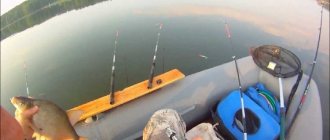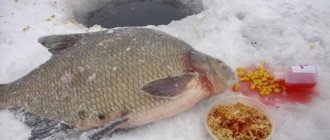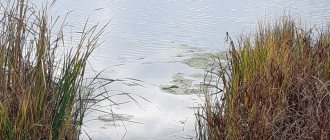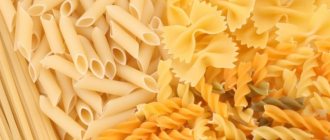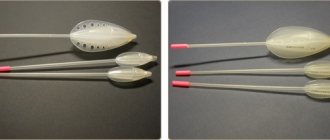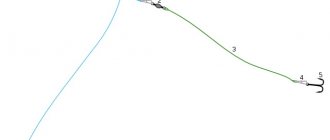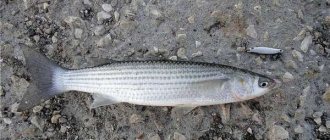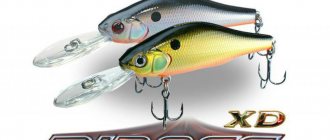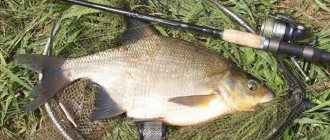Where can you go fishing? Secret place. Vuoksa.
Many people ask the question where is the best place to go fishing? Is there a place on the river where the bite is constant, the water is calm and no water equipment cuts through it?
Every fisherman knows the best place to stop, but not everyone wants to share this secret, sometimes simply out of fear that someone will steal his secret place, sometimes out of caution.
After all, everyone knows that experienced fishermen do not look for easy ways. In addition, having thoroughly browsed the pages of the Internet, it is possible to discover the disclosure of some secrets that I would like to tell you about.
The Vuoksa River originates from Finnish waters, namely Lake Saimaa. Starting from the Baryshevsky district, the bed of the not so wide river widens significantly, thereby turning into an elongated smooth lake, the width of which is approximately 2.5 km.
The total recorded length of the river is about 156 km. Moreover, on the territory of Russia, the total length of the Vuoksa River is 143 km.
And along the entire length of the river, in some places the crowd of people reaches its climax, while in others it is completely deserted. This is a simple pattern.
Therefore, if you prefer secluded fishing, you should, armed with a map, carefully study the river along its entire length, and, having visited several places near the river, choose the most suitable one for yourself.
Vuoksa is a busy moving river; you can stop for fishing either in a tent or in a comfortable house or cottage, offered for rent by specialized bases or grounds.
In any case, you will have successful fishing.
Finding that favorite treasured secret spot can take some time. But once you find it, you will be simply delighted. You won’t be able to understand right away that this is your comfort zone by the river.
Only after several trips, lasting maybe a month, or even a year, will you feel connected with nature.
Your inner feelings will help you understand that the place you have chosen is exactly the right one. As a rule, in such places you like everything and even the fish bite better than anywhere else.
You can easily study what kind of fish is found in a certain area using a map and the Internet. Based on this, select all the necessary gear, bait and additional accessories for fishing.
Water maze
It is believed that the name of the river comes from an old Karelian word that meant “to flow.” The ancient Novgorodians called it Uzerva. They also borrowed the word meaning “new lake” from the Karelians. This name remained until the beginning of the 20th century, and then the river and lake of the same name were returned to their old name - Vuoksa. Now it is the largest river of the Karelian Isthmus. Its length reaches 156 km.
Vuoksa begins in the Finnish Lake Saimaa. It is located almost at the very border with Russia and has such a complex configuration that it seems as if it consists of thousands of small reservoirs. The length of its Finnish part is only 13 km. In the border city of Imatra, the river valley is a deep, picturesque canyon. The current forms a powerful waterfall, beyond which the river crosses the state border. The length of the Russian part of Vuoksa reaches 143 km.
On the Russian side, the river immediately has to overcome the dams of the Svetogorsk and Lesogorsk hydroelectric power stations. In the area of the city of Kamennogorsk, the Vuoksa channel widens significantly, and up to the village of Shlyuz Gremuchiy it more closely resembles a long narrow lake with jagged shores and small islands. Beyond the village it becomes a river again.
Photo: The river turns into a lake, and then becomes a river again
The next expansion of the channel occurs near the village of Baryshevo. The lake, 2.5 km wide, stretches to the village of Losevo, where it ends with a narrow channel. This is where the famous Losevsky rapids are located. At this point Vuoksa flows into Lake Sukhodolskoye. The Burnaya River flows from it and flows into Lake Ladoga. This is the so-called Southern branch of Vuoksa. But the river still has a Northern branch. Let's take a virtual tour of it.
Near the village of Romashki, on the northern side, the Vuoksa-virta oxbow flows into the main channel of the Vuoksa. It flows from Lake Balakhanovskoye, which is connected by a narrow channel to Lake Trostnikovskoye. Next comes a series of small lakes and channels, which turns into a rather wide long lake near the village of Vasilyevo. This is also Vuoksa! Here you understand how complex this lake-river system is. It’s a miracle, but in this place, on the watershed, the river changes flow from south to north!
Photo: Church of St. Andrew the First-Called on Vuoksi
In front of the village of Melnikovo, another transformation takes place, and the narrow Belichya Channel separates from Vuoksa, which immediately directs its waters into the vast Lake Vuoksa. The river itself flows along the outskirts of Melnikovo and through a system of channels also flows into the lake of the same name closer to Priozersk. On the map, the lake-river system of Vuoksa looks like a real water labyrinth!
Differences between fishing in the Leningrad region on Vuoksa
In the reservoirs of the Leningrad region, the variety of fish is quite wide, about 60 species of commercial fish, some of which are called anadromous - these are those that do not stay in the river for a long time, but make their way from the sea to the river for the spawning period.
The other part is permanent, non-replaceable inhabitants of reservoirs, and the third is sea inhabitants.
Some migratory fish include:
- Baltic sturgeon;
- salmon;
- whitefish;
- smelt;
- river eel.
The Leningrad region, with about 25 thousand rivers, cannot but boast of the famous Vuoks. Its tributaries, less known and sometimes even unnamed, are famous for their abundance of fish.
So, in some there are even trout, so with the right choice of place and selection of gear, you can eventually enjoy the delicacy. The choice of places is quite large.
Anyone who wants to spend a weekend fishing will find a secluded place for themselves.
Since you can fish on Vuoksa all year round, you can find here:
- pike;
- trout;
- salmon;
- zander;
- ide;
- chub;
- whitefish
Vuoksa is a favorite fishing place for those who use spinning rods or fly fishing gear.
In Vuoksi you can find fish of almost any species from the entire North-Western region. All you need to do is find a suitable place for a certain type of fish.
Thus, in the channel between lakes Virta and Suvanta there are salmon and trout. Another interesting place that attracts the attention of tourists is Taipolen-Ioki. In addition to trout and salmon, in summer you can find pike perch, pike, and lake trout here.
Features of fishing on the Vuoksa system of rivers and lakes
On Vuoska in the Leningrad region you can go fishing in several places, since the river has its own well-coordinated system.
These include:
- Gateway Rattle. Fans of winter fishing will appreciate the closure of the fishing season at the end of autumn at the Gremuchiy lock. Pike and burbot bite best at this time. The catch, although not very rich, is worth the effort.
- Bright. You can stay in the bright city at the tourist base of the same name by renting a room or a cottage. Fishing here is a pleasure; the fishing base provides a full range of additional services. Almost all the inhabitants of Vuoks are caught.
- Baryshevo. Fishermen believe that Baryshevo is an interesting solution when choosing a fishing spot on Vuoksa. If we talk about the peculiarities of fishing in this region, then in the hot summer season it is most appropriate to catch a predator on a path along dumps at a depth of three, four or more meters.
Here, even traditional pike fishing with cables can achieve good results. Bream, including larger ones, can be caught well on boats, donks and tackle with floats thrown from a boat.
Among the potential trophies it should be noted:
- asp;
- ide;
- bream;
- roach;
- pike perch;
- Girona;
- perch;
- pike.
Fishing on Lake Vuoksa
This Friday I was going to go fishing on Svir. It was boring to travel so far alone, and I decided to call Yuri Sergeevich (lempaa) to invite him to come with me. He agreed after some persuasion. But then he called back and convinced me that it was better to go to Lake Vuoksa in Priozersk. He called one of his friends who had recently traveled to Svir and was told that there was nothing to do there. I agreed to go to Vuoksa because I had not been there for two years. Moreover, Yuri Sergeevich promised to show me all his places where he has been fishing for a long time. The weather, as always, was not pleasant, but this time there was such a downpour that the cars had to practically float instead of driving on the roads. By the time we left, the rain had already stopped, but in some places the water level was so high that some cars could not pass and drove right along the sidewalks. Due to this, there were huge traffic jams in the city and we stood for almost an hour getting out of the city. We arrived at the base in Priozersk around ten o’clock in the evening. We quickly pumped up the boat, loaded our things, talked to the fishermen, and headed out into the lake to a pre-planned spot.
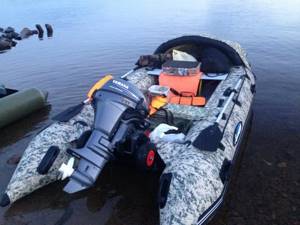
It was necessary to swim about eight kilometers by water to get to the place. The problem was that it was already getting dark, and along the way there were often shallow areas with pitfalls. It was possible to run into a stone and damage the engine. Lempaa was a guide to these places and we got to the place without catching a single pebble at the bottom.
We reached the camp already in the first hour, so the evening fishing was not a success. We set up camp, drank tea and got ready to sleep. I decided to sleep right outside, next to the boat. It was a bit difficult to drag the boat and motor ashore, and I didn’t want to wake up and find that the boat was gone. Surprisingly, there were almost no mosquitoes, and it was pleasant to sleep outdoors on an air mattress. The water is gurgling nearby, the birds are singing, there is beauty.
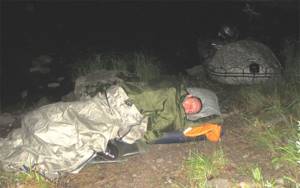
Woke up around four o'clock in the morning. Without getting up from his seat, I watched the flow of water right next to me. I tried to see the presence of fish by splashes, but apart from the singing of birds I heard and saw nothing.
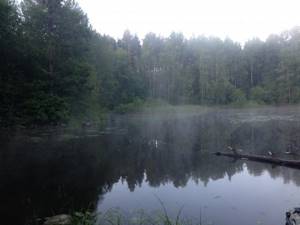
After admiring the surroundings for about ten minutes, I decided to get up and try to leave the spinning rod in the channel in a fast current. According to Yuri Sergeevich, pike often stand there. It was amazing for me. As far as I know, pike do not like to stand in fast currents. But I was wrong, literally ten minutes later my wobbler was attacked by a pike weighing about a kilogram. When trying to pull it against the current, it got caught on a stone. The clutch cracked loudly, but the cord stood still. I stopped turning the reel, waited a couple of seconds, the pike was still there. Having loosened the cord, I waited until the pike itself secured the wobbler from the stone, and continued to pull it through a strong stream of water. A minute later she was in my hands.
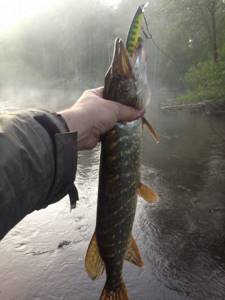
Having thrown the spinning rod around a flooded tree, it caught on a twig under water. I had to take a boat and unhook it. Well, since I had already swum out, I decided to examine the thickets of water lilies near our camp. The pike began to slowly show itself in different corners, chasing the fry. But she refused to use a wobbler.

I returned to camp to have tea. Soon Yuri Sergeevich woke up, and we decided to cast the donkeys while we were having breakfast and check the white fish. A small bream immediately responded to the donk, then a small perch. We decided to ignore the bells and have a leisurely breakfast. But one bell rang insistently and I couldn’t stand it. After hooking, I felt something heavy and the leash immediately came off. Well, okay, we thought, and went on to breakfast. Then they boarded the boat and set off to look for the predator in the immediate vicinity.
After riding for half a day through the most beautiful places of Lake Vuoksa, examining all the pike places known and unknown to Yuri Sergeevich, we still didn’t see any bites.
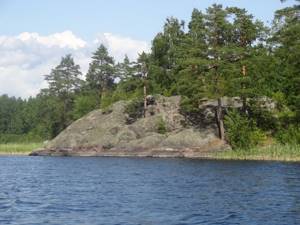
Just returning back closer to the camp, there were a couple of bites from the crayons. One jumped off Yuri Sergeevich’s hook when he lifted it out of the water. And I saw how the small child was catching up with my wobbler right next to the boat, and I stopped the wiring for a second. He grabbed the wobbler and immediately spat it back, giving no chance of hooking. Or, while watching what was happening, I forgot that I needed to hook.
Then, just before Sergeevich’s camp, a good pike bit. I quickly turned off the engine and dropped anchor. I wanted to take out the landing net, watching how the spinning rod was bending, but the pike decided not to show itself to us and disappeared into the depths. Having reached the camp, I began to pack my things, and Yuri Sergeevich practiced on small fish, which greedily grabbed a small silicone twister.
A little tired, but happy, we headed back. Having reached the base, we asked the fishermen who had arrived with us about their catches. The answer was only disappointment. It seemed that my pike was the only one caught today. But at least we talked to beautiful places in the Priozersk region.
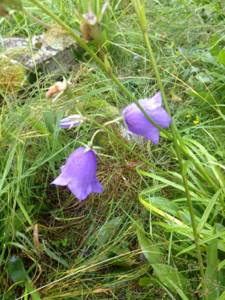
Yuri Sergeevich’s report can be read on his blog
Similar articles:
There are no similar articles.
Please rate the article
( 6 ratings, average: 4.83 out of 5)
Fishing on Vuoksi on your own, with friends or with the whole family
With whom and no matter how you relax, fishing on Vuoksi will definitely bring a lot of impressions.
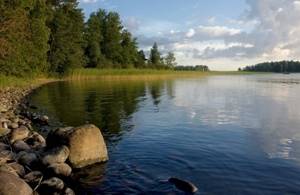
Modern accommodation conditions allow you to relax on Vuoksa on your own, staying in a camping town or on a wild coast, taking your own tent with you, fishing in a noisy company of friends, staying in a comfortable cottage, spending a weekend with the whole family, renting a country house or estate.
No matter how you want to relax - all this is possible and accessible, moreover, impressionable and interesting.
Having looked through the accommodation offers on the Internet, no one will be left without an overnight stay.
Many people judge by the area where the bases are located and are afraid to even imagine what the cost of living in a fishing area is.
It is worth saying that many of the complexes set fairly diplomatic prices, making their services accessible to everyone.
Comfort
Every person wants to relax in comfort. But everyone’s concept of comfort is different. Some people cannot live without a double bed even if they go out for one day, while others are alien to the majestic attitude - they cannot imagine life without a tent by the river.
Therefore, the type and method of placement is an individual thing for each person.
The variety of accommodation options is quite extensive and on Vuoksa everyone will be able to choose the most suitable option for themselves.
There are several categories of accommodation for vacationers on Vuoksi:
- VIP class bases;
- bases of the “standard” type;
- "economy" type bases;
- camping recreation centers.
Nature
Despite scientific and technological progress and modern construction technologies, people living near the river know that preserving the natural principle is one of human qualities.
Therefore, the construction of wooden houses and cottages on the banks of the river became unique. This placement option is the most favorable for the environment and introduces the least amount of disturbing factors into the ecosystem.
The nature of Vuoks in some places has not yet been touched by human hand, it amazes the imagination at first glance.
It is thanks to the diversity of reservoirs and its composition that Vuoksa is so rich in various types of fish, and this is what allows fishing on Vuoksa to be turned into an exciting, multifaceted activity accessible even to fishing beginners.
The well-formed riverbed of Vuoksa for recreation attracts so many fishermen and lovers of outdoor recreation. But all the beauty of nature lies in the walking routes along the banks of the river, especially in the summer.
Fishing portal
One day on Vuoksi I decided to try vertical lures and test the lures I had prepared a long time ago. Having chosen a large lead spoon, very similar to a jig, I put the roach on the hook by both lips, drove away from the shore and began to unwind the fishing line from the board. Having lowered the spoon to the bottom, I took the line in my hand and began to make cutting movements. After a few strokes, I felt a tug, hooked it and, quickly selecting the fishing line, brought the pike perch to the surface. I planted a new baitfish. Everything happened again. This time a small pike became my prey. It was getting dark, there was no time to catch live bait, so I tried fishing with a “naked” spoon. Not immediately, but a familiar bite followed, and I pulled out the second pike perch. In the morning I attached a wire loop to the hook, through which I passed the fishing line - now I had some semblance of a fishing rod. I removed the “gut” (esophagus, considered one of the best baits) from the pike and strung it like an accordion onto the hook, leaving one and a half to two centimeters freely hanging from the hook. My trophies increased, although there were a lot of empty bites.
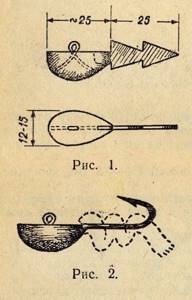
Five years have passed. I improved the spoon, developed fishing methods, and studied the habits of pike perch. This beautiful fish is a frequent guest in my catches. I want to tell you about my experience. The spoon is cast from lead in a plaster or wooden mold. Before pouring, a wire loop and a brass or copper plate are inserted into the mold (Fig. I). For fishing with the “gut”, a hook No. 12 or No. 14 is soldered in (Fig. 2). The hook or plate must first be tinned. After casting, the workpiece is filed with a file. In this case, you should ensure that the spoon suspended by the loop occupies a horizontal position.
It is advisable to have spoons of two or three different weights. The spinner is equipped with a double, threaded into a loop, to which a leash made of vein line 0.6 mm thick and about 20 cm long is attached. The leash is connected to the fishing line with a carabiner, which protects the fishing line from twisting. With the described fishing method, a pike is often caught along with the pike perch, and the leash does not allow it to cross the line. The fishing rod is made according to the type used for winter lure fishing, but should be much tougher. The length of the fishing rod is 40-50 cm. A reel is very convenient for adjusting the length of the fishing line, but you can use a reel.
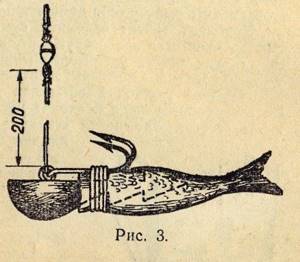
The best bait, as experience has shown, are small ruffs and perches.
To equip a spoon, the head of the fish is cut off, a plate is inserted into the abdominal cavity, and the fish is tightly wrapped with thread. The double is also attached with thread (Fig. 3). With a lure equipped in this way, you can catch several pike perch without changing the bait. Roach, rudd and bleak are less suitable: they easily fall off the hook. You can also fish with a “gut”, a very durable bait, although not as tempting as a ruff. After all, ruff is the usual food of pike perch. You can fish with the “gut” all day long without changing it. Many people believe that catching pike perch is only possible at dawn and at night. I can’t agree with this opinion: it all depends on the fishing method. Sawdust can be caught using the technique used here throughout the day, when the pike perch stops actively hunting in the reservoir and rolls into its deep parts. You need to fish starting from about four meters deep. On Vuoksa, pike perch were caught well from the end of May until October. At the same time, at all the fish sites found, the current was very weak. Pike perch usually stays in the same places, so such a place is the key to success. The most suitable for fishing is a small light boat (shuttle, oblasok, etc.), controlled by a stern oar. I had to use fofans, sometimes even four-oared ones. Fishing alone from a large boat, especially in windy weather, is very difficult. If there are two anglers, there will be no difficulties. In very strong winds, only one can fish; the other must sit on the oars and hold the boat with its bow to the wind. To catch, you need to lower the spoon to the bottom, and then throw it up with a strong movement, reminiscent of hooking when fishing with a winter spoon. The spoon should “knock” on the bottom. She must not be allowed to drag. This can lead to snags. It is absolutely necessary that the fishing line be positioned vertically, then it is easier for the angler to “feel” the bottom. I fish with veined fishing lines from 0.3 to 0.45 mm thick and I don’t remember any cases of breakage, although I had to pull out pike perch weighing up to 2 kg. The pike perch's mouth is hard, and therefore the bite must be accompanied by a strong hook. The greater depth and elasticity of the fishing line protects against breakage. Very often, the pike perch does not catch, but holds the spoon tightly in its teeth and releases it only when it gets into the landing net. Therefore, you need to choose the line quickly, without allowing the fish to come to its senses. Fishing with a reel does not provide the required speed and continuity of movements, so I don’t use it for fishing. You should also hook if it seems to you that a hook has occurred; this is exactly the impression that is created when biting large pike perch and pike. Pike perch is a schooling fish: having caught one, you can hope that there are others nearby. In order not to lose the fish’s resting place, when I bite, I throw a buoy into the water - the chamber of a soccer ball with a lead sinker cast in the shape of the letter “H” and a supply of cord on it. Having pulled out the fish, I rise above the buoy, lower the spoon and, moving downstream, try to get as close as possible to the place of the previous bite. It should be noted that searching for pike perch requires a lot of patience and perseverance from the fisherman. Often it was necessary to lure for many hours in a row to no avail before it was possible to find a fish site, but then the fishing began, rewarding all the hours of hard work. When fishing, it is necessary to have a cutter and a yoke with a spinner fork for removing a pike perch or pike from the mouth. I also used the described spinner, not without success, when fishing on the track and with a spinning rod.
